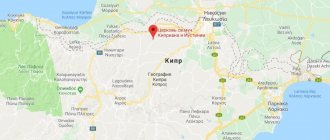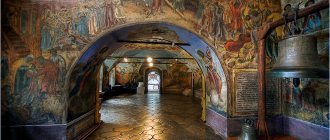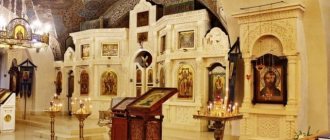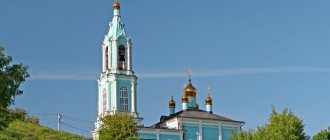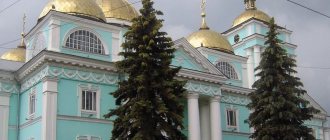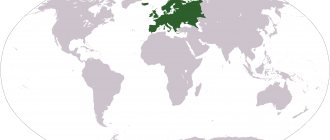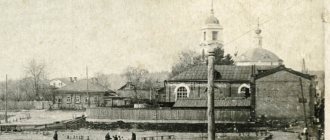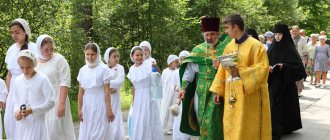Mir
Ukraine Kyiv Kiev Theological Academy and Seminary Loading map...
{"format":"leaflet","minzoom":false,"maxzoom":false,"limit":50,"offset":0,"link":"all","sort":[""], "order":[],"headers":"show","mainlabel":"","intro":"","outro":"","searchlabel":"\u2026 \u0441\u043b\u0435\ u0434\u0443\u044e\u0449\u0438\u0435 \u0440\u0435\u0437\u0443\u043b\u044c\u0442\u0430\u0442\u044b","default":"","import-annotation":false,"width ":"auto","height":"350px","centre":{"text":"","title":"""link":"","lat":50.43249999999999744204615126363933086395263671875,"lon": 30.559166999999998637349563068710267543792724609375,"icon":""},"title":"","label":"","icon":"","lines":[],"polygons":[],"circles":[ ],"rectangles":[],"copycoords":false,"static":false,"zoom":8,"defzoom":14,"layers":["OpenStreetMap"],"image layers":[] ,"overlays":[],"resizable":false,"fullscreen":true,"scrollwheelzoom":true,"cluster":false,"clustermaxzoom":9,"clusterzoomonclick":true,"clustermaxradius":80, "clusterspiderfy":true,"geojson":"","clicktarget":"","showtitle":true,"hidenamespace":false,"template":"","userparam":"","activeicon": "","pagelabel":false,"ajaxcoordproperty":"","ajaxquery":"","locations":[{"text":"\u003Cb\u003E\u003Ca href=\"/palomnik/%D0% 9A%D0%B8%D0%B5%D0%B2%D1%81%D0%BA%D0%B0%D1%8F_%D0%B4%D1%83%D1%85%D0%BE%D0%B2% D0%BD%D0%B0%D1%8F_%D0%B0%D0%BA%D0%B0%D0%B4%D0%B5%D0%BC%D0%B8%D1%8F_%D0%B8_%D1% 81%D0%B5%D0%BC%D0%B8%D0%BD%D0%B0%D1%80%D0%B8%D1%8F\" title=\"\u041a\u0438\u0435\u0432\u0441\ u043a\u0430\u044f \u0434\u0443\u0445\u043e\u0432\u043d\u0430\u044f \u0430\u043a\u0430\u0434\u0435\u043c\u0438\u044f \u0438 \ u0441\u0435\u043c\u0438\u043d\ u0430\u0440\u0438\u044f\u003E\u041a\u0438\u0435\u0432\u0441\u043a\u0430\u044f \u0434\u0443\u0445\u043e\u0432\u043d\u0430\u 044f\u0430\u043a\u0430\ u0434\u0435\u043c\u0438\u044f \u0438 \u0441\u0435\u043c\u0438\u043d\u0430\u0440\u0438\u044f\u003C/a\u003E\u003C/b\u003E\u003 Chr /\u003E\u003Ca href= \"/palomnik/%D0%A1%D0%B2%D0%BE%D0%B9%D1%81%D1%82%D0%B2%D0%BE:%D0%90%D0%BD%D0%BD %D0%BE%D1%82%D0%B0%D1%86%D0%B8%D1%8F\" title=\"\u0421\u0432\u043e\u0439\u0441\u0442\u0432\u043e:\u0410\ u043d\u043d\u043e\u0442\u0430\u0446\u0438\u044f\»\u003E\u0410\u043d\u043d\u043e\u0442\u0430\u0446\u0438\u044f\u003C/a\u003E: \u0441\u0440\u0435 \u0434\u043d\u0435\u0435 \u0431\u043e\u0433\u043e\u0441\u043b\u043e\u0432\u0441\u043a\u043e\u0435 \u0443\u0447\u0435\u0431\ u043d\u043e\u0435\u0437\u0430 \u0432\u0435\u0434\u0435\u043d\u0438\u0435 \u0423\u043a\u0440\u003Cspan class=\»smw-highlighter\» data-type=\»2\» data-state=\»persistent\» data -title=\»\u0418\u043d\u0444\u043e\u0440\u043c\u0430\u0446\u0438\u044f\» title=\»\u0441\u0440\u0435\u0434\u043d\u0435\u0435\u0431\u04 3e\ u0433\u043e\u0441\u043b\u043e\u0432\u0441\u043a\u043e\u0435 \u0443\u0447\u0435\u0431\u043d\u043e\u0435 \u0437\u0430\u0432\u0 435\u0434\u0435\u043d\u0438\ u0435 \u0423\u043a\u0440\u0430\u0438\u043d\u0441\u043a\u043e\u0439 \u041f\u0440\u0430\u0432\u043e\u0441\u043b\u0430\u0432\u0 43d\u043e\u0439\u0426\u0435\ u0440\u043a\u0432\u0438, \u0440\u0435\u0430\u043b\u0438\u0437\u0443\u044e\u0449\u0435\u0435 \u0441\u0442\u0430\u043d\u0434\u 0430\u0440\u0442\u0431\u043e \u0433\u043e\u0441\u043b\u043e\u0432\u0441\u043a\u043e\u0433\u043e (\u0442\u0435\u043e\u043b\u043e\u0433\u0438\u0447\u0435\u 0441\u043a\u043e\u0433\ u043e) \u043e\u0431\u0440\u0430\u0437\u043e\u0432\u0430\u043d\u0438\u044f \u0441 4-\u0433\u043e\u0434\u043e\u0432\u044b\u043 c \u0441\u0440\u043e\u043a \u043e\u043c \u043e\u0431\u0443\u0447\u0435\u043d\u0438\u044f. \u0421\u0435\u043c\u0438\u043d\u0430\u0440\u0438\u044f \u0433\u043e\u0442\u043e\u0432\u0438\u0442 \u0441\u0432\u044f\u0449\ u0435\u043d\u043d\u043e\u0441 > e\u0432\u043d\u043e\u0441\ u043b\u0443\u0436\u0438\u0442\u0435\u043b\u0435\u0439 \u0441\u043e\u0433\u043b\u0430\u0441\u043d\u043e \u0441\u0442\u0430\u0 43d\u0434\u0430\u0440\u0442\ u0443\u0434\u0443\u0445\u043e\u0432\u043d\u043e\u0433\u043e\u043e\u0431\u0440\u0430\u0437\u043e\u0432\u0430\u043d\u0438\u0 44f\u0423\u041f\u0426.\u0421 \u0435\u043c\u0438\u043d\u0430\u0440\u0438\u044f \u0433\u043e\u0442\u043e\u0432\u0438\u0442 \u0441\u043f\u0435\u0446\u0438\ u0430\u043b\u0438\u0441\u0442 \u043e\u0432 \u043e\u0431\u0440\u0430\u0437\u043e\u0432\u0430\u0442\u0435\u043b\u044c\u043d\u043e-\u043a\u0432\u0430\u043b\ u0438\u0444\u0438\u043a\ u0430\u0446\u0438\u043e\u043d\u043d\u043e\u0433\u043e \u0443\u0440\u043e\u0432\u043d\u044f: \u0431\u0430\u043a\u0430\u043b\u 0430\u0432\u0440\»\u003E \u003Cspan class=\»smwtext\»\u003E \u2026 \u003C/span\u003E\u003Cspan class=\»smwttcontent\»\u003E\u0441\u0440\u0435\u0434\u043d\u0435\u0435 \u0431\ u043e\u0433 \u043e\u0441\u043b\u043e\u0432\u0441\u043a\u043e\u0435 \u0443\u0447\u0435\u0431\u043d\u043e\u0435 \u0437\u0430\u0432\u0435\ u0434\u0435\u043d\u0438\u0435 \u0423\u043a\u0440\u0430\u0438\u043d\u0441\u043a\u043e\u0439 \u041f\u0440\u0430\u0432\u043e\u0441\u043b\u0430\u0432\u043d\u 043e\u0439\u0426\u0435\u0440 \u043a\u0432\u0438, \u0440\u0435\u0430\u043b\u0438\u0437\u0443\u044e\u0449\u0435\u0435 \u0441\u0442\u0430\u043d\u0434\u0430 \u0440\u0442 \u0431\u043e\ u0433\u043e\u0441\u043b\u043e\u0432\u0441\u043a\u043e\u0433\u043e (\u0442\u0435\u043e\u043b\u043e\u0433\u0438\u0447\u0435\u04 41\u043a\u043e\u0433\u043e ) \u043e\u0431\u0440\u0430\u0437\u043e\u0432\u0430\u043d\u0438\u044f \u0441 4-\u0433\u043e\u0434\u043e\u0432\u044b\u043c \u 0441\u0440\u043e\u043a\ u043e\u043c \u043e\u0431\u0443\u0447\u0435\u043d\u0438\u044f. \u0421\u0435\u043c\u0438\u043d\u0430\u0440\u0438\u044f \u0433\u043e\u0442\u043e\u0432\u0438\u0442 \u0441\u0432\u044f\u0449\ u0435\u043d\u043d\u043e\u0441 > e\u0432\u043d\u043e\u0441\ u043b\u0443\u0436\u0438\u0442\u0435\u043b\u0435\u0439 \u0441\u043e\u0433\u043b\u0430\u0441\u043d\u043e \u0441\u0442\u0430\u0 43d\u0434\u0430\u0440\u0442\ u0443\u0434\u0443\u0445\u043e\u0432\u043d\u043e\u0433\u043e\u043e\u0431\u0440\u0430\u0437\u043e\u0432\u0430\u043d\u0438\u0 44f\u0423\u041f\u0426.\u0026lt ;/br\u0026gt;\u0026lt;/br\u0026gt;\u0421\u0435\u043c\u0438\u043d\u0430\u0440\u0438\u044f \u0433\u043e\u0442\u043e\u0432\u0438\u 0442\u0441\u043f \u0435\u0446\u0438\u0430\u043b\u0438\u0441\u0442\u043e\u0432 \u043e\u0431\u0440\u0430\u0437\u043e\u0432\u0430\u0442\u0435\u 043b\u044c\u043d\u043e-\ u043a\u0432\u0430\u043b\u0438\u0444\u0438\u043a\u0430\u0446\u0438\u043e\u043d\u043d\u043e\u0433\u043e \u0443\u0440\u043e\u04 32\u043d\u044f:\u0431\u0430 > 0430\u043b\u0438\ u0444\u0438\u043a\u0430\u0446\u0438\u043e\u043d\u043d\u043e\u0433\u043e \u0443\u0440\u043e\u0432\u043d\u044f: \u0431\u0430\u 043a\u0430\u043b\u0430\u0432 \u0440","title":"\u041a\u0438\u0435\u0432\u0441\u043a\u0430\u044f \u0434\u0443\u0445\u043e\u0432\u043d\u0430\u044f \u0430\u043a\ u0430\u0434\ u0435\u043c\u0438\u044f \u0438 \u0441\u0435\u043c\u0438\u043d\u0430\u0440\u0438\u044f","link":"","lat":50.4324999999999974420461512 6363933086395263671875,"lon":30.559166999999998637349563068710267543792724609375,"icon ":""}],"imageLayers":[]}
50.432548; 30.559321
Ukraine, Kyiv, Lavrskaya street, 25k64
Kyiv
Ukraine
Phones
:
Telephone
:
Kyiv Theological Academy
- a higher theological educational institution of the Ukrainian Orthodox Church, which is a scientific, theological and educational center that trains clergy, teachers of theological educational institutions, church scientists, etc.
The Academy trains specialists at the educational qualification level: Candidate of Theology, Master of Theology.
Kyiv Theological Seminary
- a secondary theological educational institution of the Ukrainian Orthodox Church, implementing the standard of theological (theological) education with a 4-year period of study. The seminary prepares clergy and clergy according to the standard of spiritual education of the UOC.
The seminary prepares specialists at the educational and qualification level: bachelor.
Kiev-Brotherly School
The primary source of the Kyiv Theological Academy and Seminary is the Kiev Brotherhood School, which appeared on the basis of the Epiphany Monastery in 1615. Its appearance was realized according to the idea of Archimandrite Elisha Pletenetsky. According to his plan, classical languages, rhetoric, theology and a number of areas of elementary education were to be studied here. Later, Metropolitan of Kiev Peter Mohyla contributed to the unification of his school with the Kiev-Bratskaya school. After some time, the institution changed its status and became the Kiev-Mohyla Collegium.
Church of the Nativity of the Blessed Virgin Mary[[edit]h2>
Church of the Nativity of the Blessed Virgin Mary
The temple of the Kiev Theological Academy and Seminary is located in the Far Caves of the Holy Dormition Kiev-Pechersk Lavra and is consecrated in honor of the Nativity of the Blessed Virgin Mary. Like the Theological School itself, it has a long and rich history: built in 1696 at the expense of a relative of Hetman Ivan Mazepa
Belaya Tserkov Colonel
Konstantin Mokievsky
. The academic temple is an architectural monument and is an example of Ukrainian baroque.
The church has undergone changes several times: it has been completed and decorated several times. In 1767, extensions were made to all 4 corners of the temple, which were decorated with four domes. In 1784, a new wooden iconostasis in the Rococo style with silver royal doors was carved for the temple. Subsequently, like the royal doors of the Church of the Exaltation of the Cross, the gates of the Church of the Nativity of the Virgin Mary ended up in the Museum of Art in Los Angeles (USA); the iconostasis, unfortunately, was not preserved. In 1817, the temple was painted in the academic style by Ivan Kvyatkovsky.
During Soviet times, the temple was closed; after its opening, it was restored and re-painted. The iconostasis was completed in the late 1980s. Masters of the Trinity-Sergius Lavra in the canonical icon-painting style of the 15th-16th centuries.
Repairs and new painting of the temple took place during 2021 during the rectorship of Metropolitan
Anthony
of Boryspil and Brovary , manager of the affairs of the Ukrainian Orthodox Church.
The consecration of the temple took place on November 26, 2021. The temple was consecrated by the Primate of the Ukrainian Orthodox Church, His Beatitude Metropolitan Onuphry of Kiev and All Ukraine,
in the co-service of the UOC episcopate, academic clergy and guests in holy orders.
Around the temple there is a necropolis on which clergy and secular persons who had significant services to the Church and the state are buried: Archimandrites Ambrose
and
Anthony
, now canonized by the Ukrainian Orthodox Church as the mistress of the holy Kiev diocese,
Hieroschemamonk Vassian the Blind
,
daughter
of the writer
S.T.
Aksakova Sofia , Major General
Platon Golubtsov
with his wife, Senator
V. Ilyashenko
, heroes and participants in the Patriotic War of 1812.
Kiev-Mohyla Collegium
The work format of this institution was similar to its foreign counterparts, in which Mogila himself received his education. As part of the program, students studied languages, arithmetic, poetry, rhetoric, theology, music, catechism and philosophy. Also on Saturdays, students attended debate classes. The educational institution was headed by the rector, and he delegated some of the powers to the perfect and the superintendent. Famous personalities who studied here are Lazar Baranovich, Feofan Prokopovich, Innokenty Gizel, Stefan Yavorsky.
Kiev-Mohyla Academy
The educational institution received academy status in 1701. In connection with these changes, several more sciences and languages began to be taught here:
- geography;
- mathematics;
- natural history;
- French;
- German;
- Hebrew language;
- painting;
- architecture;
- medicine;
- rural and home economics;
- supreme eloquence.
By the end of the 18th century, the teaching staff numbered more than twenty people, and the local library contained more than ten thousand books. The main part of the curriculum was based on foreign sources. The only exceptions were theology, which was studied according to Prokopovich’s system, and rhetoric, the basis of which was prescribed in Lomonosov’s manual.
At the end of the 18th century, serious changes began in the life of the academy. During this period, the state began to allocate some funds for her needs, which greatly simplified the life of clergy. The high level of education allowed school students to easily enter academies and seminaries in Moscow, St. Petersburg and Kazan. After some time, its popularity faded significantly due to the emergence of Moscow and Kharkov universities. By decision of the Synod, the Kiev-Mohyla Academy was closed in 1817.
History[[edit]h2>
Kiev Theological Academy[[edit]h3>
Kiev-Brotherly School (1615-1631)[[edit]h4>
Initially, in 1615, by Archimandrite Elisha Pletenetsky
The Kiev Brotherhood School was established in the Epiphany Monastery, intended for the study of classical languages, rhetoric, theology and some subjects of elementary education.
Kiev Metropolitan Peter Mohyla
merged this school with the school he founded; the institution subsequently received the title of a higher educational institution, known as the Kiev-Mohyla Collegium (1631-1701).
Kiev-Mohyla Collegium (1631-1701)[[edit]h4>
In its basic character, the college was reminiscent of the foreign colleges and academies in which Mogila himself studied. The following were taught here: languages (Slavic, Greek and Latin), singing and elementary music theory (according to the European model), catechism, arithmetic, poetry, rhetoric, philosophy and theology; The students were divided into eight classes: analogy, or headlight, infima, grammar, syntaxima, pyitics, rhetoric, philosophy and theology. In addition to studying these subjects, the students practiced debates every Saturday. The officials in charge were: the rector, the prefect (inspector and housekeeper) and the superintendent (overseer of the deanery of the pupils); Among the figures of this board, the most famous are: Innocent Gisel
,
Joasaph of Krokovsky
,
Lazar Baranovich
,
Ioanniky Golyatovsky
,
Anthony of Radzivilovsky
,
Gabriel of Dometsky
,
Varlaam Yasinsky
,
St.
Demetrius (Tuptalo) ,
Stefan Yavorsky
,
Theophylact Lopatinsky
,
Feofan Prokopovich
,
St.
Innokenty Kulchinsky and
Gabriel Buyaninsky
.
Kiev-Mohyla Academy (1701-1817)[[edit]h4>
In 1701, the college was renamed an academy, and the range of sciences was expanded: the languages French, German and Hebrew, natural history, geography, and mathematics were introduced; For some time, architecture and painting, higher eloquence, rural and home economics, medicine and Russian rhetoric were also taught.
The number of teachers by the end of the 18th century reached 20 or more; the academic library had more than 10,000 books. From 1759 theology was taught according to the system of Feofan Prokopovich
Lomonosov's
manual of eloquence , other subjects, mainly - according to foreign manuals.
At first, the external well-being of the academy was unenviable. The students, whose number reached 500, were partly supported by monastery funds, partly they themselves collected donations around the city in money, food and firewood; They dispersed to the cities and villages of the Kyiv and Chernigov provinces to collect alms, and sang sacred poems in front of the windows of houses. Before the holidays of the Nativity of Christ and Easter, they walked with a star, a nativity scene and a paradise. In the summer, they gathered in traveling groups and scattered to different areas in order to earn food for themselves by singing cants, performing dramas, tragedies and comedies, pronouncing poems and speeches, and holding services in parish churches. Donations from the Court, clergy, nobles and hetmans somewhat eased the lot of the poor. From the end of the 18th century. The government began to allocate special sums for the maintenance of the academy. The Kiev Academy is important in the history of Russian education in the 18th century.
A significant number of figures emerged from it in various fields of public service: its students became teachers at the Moscow Slavic-Greek-Latin Academy, the St. Petersburg Alexander Nevsky Seminary and the Kazan Academy; they re-established many seminaries.
With the advent of Moscow University (1755) and Kharkov University (1805), the importance of the Kiev-Mohyla Academy fell. By order of the government and the decree of the Synod of August 14, 1817, it was closed. At the same time, the Kyiv Theological Seminary was established in Kyiv.
Kiev Theological Academy (1819-1919)[[edit]h4>
The Kiev Theological Academy was opened “in its new structure” on September 28, 1819 in its historical place, in the Brotherhood Epiphany School Monastery.
Activities of the Kiev Theological Academy and outstanding scientists and historians, professors of the KDA, who lived on Andreevsky Spusk: Afanasy Bulgakov
,
Stepan Golubev
,
Pyotr Kudryavtsev
,
Fyodor Titov
,
Alexander Glagolev
and others, several museum showcases of the Kiev One Street Museum are dedicated.
There is debate in the scientific community about whether the Kyiv Theological Academy can be considered the successor to the Kiev-Mohyla Academy, since after the reform of 1819 the educational process completely changed and only one person was retained from among the old teaching staff.
Closure during the years of Soviet power[[edit]h4>
In 1919, the Kiev Theological Academy was officially closed by the Soviet authorities. In Soviet times, a naval political school was located on its territory. However, classes continued for several more years at the newly created Orthodox Theological Academy, which was headed by the last rector of the KDA, Archpriest Alexander Glagolev
, and the teachers were the professors who remained in Kyiv. This academy did not have a specific premises; classes were held in private apartments. There is information that it existed back in 1925.
Kiev Theological Seminary[[edit]h3>
The Kiev Theological Seminary was established in connection with the publication of the new Charter of theological schools of the Russian Orthodox Church of 1808, which provided for a three-stage education system. The Kiev-Mohyla Academy was transformed according to this charter in 1817-1819. The Kiev Theological Seminary, equipped with a new teaching corps mainly consisting of graduates of the St. Petersburg Theological Academy, began its work on October 27, 1817.
On September 28, 1819, the seminary was transferred to a building located on the banks of the Dnieper and formerly known as “bursa”. In 1832 it was again moved to the buildings of the former Greek Peter and Paul Monastery.
During the Civil War, the seminary ceased to exist.
In 1945, the Council of Ministers of the USSR gave its consent to the opening of pastoral and theological courses in Kyiv. In 1946, the process of transforming courses into theological seminaries began, and the Kiev Theological Seminary was inaugurated on February 18, 1947.
Initially, the Kyiv Seminary was located in the St. Michael's Monastery. In 1949, this monastery was closed, and the theological school was forced to move to the stylobate of St. Andrew's Church - a place unsuitable for an educational institution.
In 1959, the Ukrainian authorities began secret preparations for the closure of the Kyiv Seminary. May 4, 1960 at a meeting with Patriarch Alexy
Chairman of the Council for the Affairs of the Russian Orthodox Church
V. A. Kuroyedov
demanded the liquidation of the Kiev Seminary.
The Patriarch was forced to do this, and on June 8 of the same year, the Educational Committee of the Holy Synod decided to close the seminary. The students were transferred to the Odessa Theological Seminary.
Closure in Soviet times
The official liquidation of the Kyiv Theological Academy occurred in 1919 by decision of the Soviet authorities. By their order, the seminary building was converted into a Naval Political School, but despite these changes, religious citizens created a small Orthodox Theological Academy, headed by the former rector of the Kyiv Theological Academy, Alexander Glagolev. It was here that those who decided to devote themselves to religious service were trained. It is worth noting that the educational institution did not have its own building. Teachers gave lectures in private apartments. There is information that this format of training existed until 1925.
New life for the academy
After the collapse of the USSR, Ukraine received complete independence, and religious trends in the country received a new branch of development. Thus, in 1992, the Ukrainian Orthodox Church and the Ukrainian Orthodox Church of the Kyiv Patriarchate created the Kyiv Theological Academy on their own initiative - this is how two independent seminaries with the same names appeared. The founders claimed that each of these religious institutions was the successor to the academy, which closed in 1919. Later, the Church of the Kyiv Patriarchate nevertheless decided to rename its educational institution the Kyiv Orthodox Theological Academy.
Modern "Kyiv Theological Academy"
The founding place of the educational institution was the Kiev Pechersk Lavra. Graduates receive the qualifications of Candidate of Theology and Master of Theology. The journal “Proceedings of the Kyiv Theological Academy” is considered an honorary publication.
Applicants from different countries want to study at the educational institution. Currently, guests from Serbia, Greece and Poland are undergoing training. Humanities and theology are studied here, which allows graduates to be not only religiously educated, but also to gain deep knowledge in a variety of areas (languages, philosophy, history, and others). Musically gifted students can try their hand at the choir of the Kyiv Theological Academy, which is known throughout the world.
Literature
- Askochensky V.I.
Kiev with its oldest school, the Academy. - K., 1856. - parts 1, 2. - Askochensky V.I.
History of the Kiev Theological Academy after its transformation in 1819. - St. Petersburg, 1863. - Barsov N.I.
Orthodox spiritual academies // Encyclopedic Dictionary of Brockhaus and Efron: in 86 volumes (82 volumes and 4 additional). - St. Petersburg, 1890-1907. - Biographical dictionary of graduates of the Kyiv Theological Academy. 1819-1920s T. 1: A-J. - K., 2014. - 576 p.
- Biographical dictionary of graduates of the Kyiv Theological Academy. 1819-1920s T. 2: K-P. - K., 2015. - 624 p.
- Biographical dictionary of graduates of the Kyiv Theological Academy. T.3: R - Ya.K., 2021. - 640 p.
- Vishnevsky D.
Kiev Academy in the first half of the 18th century. - K., 1903. - Golubev S. T.
History of the Kiev Theological Academy, vol. 1; pre-Mogilyan period. - K., 1886. - Golubev S. T.
Kiev Metropolitan Peter Mohyla and his associates. Experience of historical research. - K., 1883. - T. 1; 1898. - T. 2. - Golubev S. T.
Kiev-Mohyla Collegium during the life of its founder, Metropolitan of Kiev Peter Mohyla. - K., 1890. - Theological and educational institutions // Encyclopedic Dictionary of Brockhaus and Efron: in 86 volumes (82 volumes and 4 additional). - St. Petersburg, 1890-1907.
- Kiev Theological Academy / K. K. Krainy // Great Russian Encyclopedia: [[in 35 volumes] ch. ed. Yu. S. Osipov. — M.: Great Russian Encyclopedia, 2004—2017.
- Linchevsky M.
Pedagogy of ancient fraternal schools and mainly the ancient Kiev Academy // TKDA. — 1870. - Macarius (Bulgakov), Hierom.
History of the Kyiv Theological Academy. - St. Petersburg, 1843. - Malyshevsky I.I.
Historical note on the state of the Kiev Theological Academy in the past fiftieth anniversary // TKDA. - 1869. - No. 4. - Petrov N.I.
Acts and documents related to the history of the Kiev Academy. - K., 1904-1907. - T. 1-5. - Petrov N.I.
Kiev Academy during the hetmanship of Kirill Razumovsky. - K., 1905. - Petrov N.I.
Kiev Academy in the second half of the 17th century. - K., 1895. - Petrov N.I.
About verbal sciences and literary studies at the Kiev Theological Academy from its beginning to its transformation in 1819 // TKDA. - 1866-1868. - No. 4. - Serebrennikov V.
Kiev Academy from the half of the 18th century. before its transformation in 1819. - K., 1896-1897. - Titov F. I.
Imperial Kiev Theological Academy. 1615-1915. - Reprint. ed. - K., 2003. - Titov F. I.
The Old Church of Light in Kiev Ukraine, end of XVI - rev. XIX century - K., 1924. (Ukrainian)
Principle of admission to the academy
The duration of study at the Kyiv Theological Academy is two years. Only men under the age of thirty-five can become students of an educational institution. All applicants undergo preliminary training at the seminary and receive the first category. It is worth noting that the seminary diploma must have no C grades. Before becoming students, applicants must successfully pass an interview and exams in such subjects as church history, English, dogmatic theology, and the Holy Scriptures of the New and Old Testaments. A complete list of documents required for admission is presented on the official website of the academy. You must come to the entrance exams with a passport and military ID. Students admitted to the academy are provided with free food and accommodation in a dormitory with personal services. Training here is absolutely free. There are no scholarships for excellent students at the Kyiv Theological Academy.
To the applicant[[edit]h2>
Rules for admission to the Kyiv Theological Academy[[edit]h3>
Kyiv Theological Academy
- a higher educational institution of the Ukrainian Orthodox Church, which trains clergy, teachers of religious educational institutions and specialists in the field of theological science for church institutions. Duration of study (master's degree) - 2 years.
The Academy accepts persons under the age of 35 who have successfully completed the seminary in the first category (without C grades).
Applicants must undergo an interview and pass oral examinations in the following disciplines:
- Dogmatic Theology;
- Holy Scripture of the Old and New Testaments;
- Church history;
- English language.
A list of documents required for admission to the academy can be found on the academy’s website.
During the period of entrance exams, applicants must have a passport and a military ID or registration certificate. Documents are accepted only if all documents are available. The time of entrance exams is announced when submitting documents to the office.
Phones
:
office
: 255-11-79;
duty
: 255-11-79;
correspondence sector
: 255-12-18.
All students are provided with free meals and a hostel with amenities. Training is free. No stipend is paid. Students of theological schools use the Academy's library. Books and teaching aids are not sent to applicants.
Only persons in holy orders and laypeople who perform permanent obedience under diocesan administrations are accepted for study at the correspondence department.
Rules for admission to the Kyiv Theological Seminary[[edit]h3>
Kyiv Theological Seminary
- a higher educational institution that trains clergy.
Duration of training - 4 years.
The seminary accepts males of the Orthodox faith under the age of 35, who have completed secondary or higher education, who are single or married in their first marriage.
Applicants must undergo an interview and pass oral examinations in the following disciplines:
- Biblical history of the Old and New Testaments,
- Fundamentals of Orthodox Faith,
- write an essay on a biblical or church historical topic,
- show a solid and meaningful knowledge of prayers by heart:
initial
: “Glory to you, our God, glory to you”, “Heavenly King”, “Holy God”, “Holy Trinity”, “Our Father”, “Come let us worship”;
morning
: “Rising from sleep”, “God, cleanse me, a sinner”, “My Most Holy Lady, Mother of God”, “Holy Angel”;
evening
: “Eternal God”, “Almighty is the word of the Father”, “Good Tsar Good Mother”, “Guardian Angel”;
Mother of God
: “Virgin Mother of God, rejoice”, “It is worthy to eat”, “To the chosen Governor”, “The door of mercy”, “Imams have no other help”;
and
- a symbol of faith, the commandments of Moses, the Beatitudes, the troparion to one’s saint, psalms 50 and 90, troparions of the twelve feasts, prayer before communion, prayer to St. Ephraim the Syrian.
Applicants must be able to read the Psalter in Church Slavonic, know the basic church hymns and have experience in choir obedience.
The list of documents required for admission to the seminary can be found on the seminary website.
During the period of entrance exams, applicants must have a passport and a military ID or registration certificate. Documents are accepted only if all documents are available. The time of entrance exams is announced when submitting documents to the office.
All students are provided with free meals and a hostel with personal services.
Students of theological schools use the academy's library. Books and teaching aids are not sent to applicants.
For foreign applicants[[edit]h3>
Citizens of foreign countries who came to Ukraine to study are obliged to observe and comply with the rules of stay in Ukraine in accordance with the decision of the Cabinet of Ministers of Ukraine dated December 29, 1995 No. 1074.
Upon arrival at the educational institution indicated on the visa, foreigners are required to hand over their national passports to the administrations of the institutions within 3 calendar days to extend their stay in Ukraine.
Citizens of foreign countries, when applying for permits to stay in Ukraine, are required to take out a medical insurance policy.
To extend the period of stay, documents are submitted by the educational institution to the UPRF service no later than 3 working days before the end of registration.
Foreigners whose national passports are expiring are required to promptly renew or replace them, and notify the administration of the educational institution about this.
A foreigner who has entered into an agreement to live in a dormitory is obliged to comply with the rules of living in the dormitory.
A foreigner can register for residence at a private address, provided:
— Conclusion of an agreement with the owner of the apartment, certified by the housing authority at the place of residence,
— A copy of the apartment owner’s passport, with confirmation of registration at the specified address,
— Permission from the UPRF service, issued with the permission of the educational institution.
When traveling abroad or to other cities of Ukraine, foreigners are required to inform the administration of the educational institution.
After completing the training or when switching off, the foreigner is obliged to leave Ukraine within the established time frame.
In case of violation of these rules, a foreigner:
- Through the judiciary, he is brought to administrative responsibility, fines are paid in the amount of 340-680 hryvnia,
— Detention in the police department from 3:00 to 1 day of stay in view of the court,
— Expulsion from Ukraine at the expense of a foreigner,
— Bringing to criminal liability in accordance with the legislation of Ukraine.
List of documents that foreigners must provide to the office of the KDAiS upon admission
:
- Standard form
- A copy of the education document and grades received in academic disciplines
- Document confirming the absence of HIV infection
- Medical certificate of health, certified by the official health authority of the country from which the foreigner arrived, and issued no later than 1 month before departure to study in Ukraine
- Insurance policy for the provision of emergency medical care (except for foreigners from countries with which an agreement has been drawn up on the provision of emergency medical care free of charge)
- A copy of the birth document
- 6 photos 6x48
- Return ticket with an open date for returning to your home country for up to one year.
Rectors
During the existence of the seminary, more than twenty talented rectors were at its leadership. The Kyiv Theological Seminary" was ruled by the following legendary personalities in different periods:
- Archbishop Moses - the period of his service in this position was 1819 -1823.
- Innokenty Borisov is the legendary rector of the Kyiv Theological Academy and Seminary. He worked in this position since 1830 for nine years. He is considered a very famous preacher, a member of the Russian Academy. He also has an honorable place in the Holy Synod.
- Metropolitan Ioannikiy is a bishop of the Russian Orthodox Church and rector of the Kyiv Theological Seminary in the period from 1859-1860. He is known to the world for having founded three spiritual magazines. In 2021, he was canonized as a locally revered saint.
- Bishop Michael - led the academy from 1877 to 1883. The spiritual writer and theologian wrote dozens of well-known works in religious circles. “Biblical Science”, “Essay on the History of Biblical Interpretation”, “Prophetic Books of the Old Testament” are his works.
- Platon Rozhdestvensky was at the helm from 1902 to 1907. After the Kyiv Theological Academy, he headed the North American Diocese. He was removed from this position three times.
- Nikolay Zabuga - rector from 1994 to 2007. From 2005 to 2007 he was chairman of the department for external church relations of the Orthodox Church of Ukraine.
- Metropolitan Anthony - led the seminary for ten years from 2007 to 2021. Author of such important religious books as “Simple Truths”, “Learning to Trust God”, “Don’t Walk Alone”.
- Bishop Sylvester - assumed the position of rector in 2021 and holds this title to this day. He holds the Order of St. Peter the Mogila and St. Nestor the Chronicler.
All representatives of the leadership positions of the “Kyiv Theological Seminary” are outstanding personalities and excellent mentors.
Orthodox Life
Historical memory consists not only of knowledge of historical dates or facts, but includes a certain chain from the life of the holy people of the Church.
Mikhail Emmanuilovich Posnov (1873-1931)
In recent years, more and more attention has been paid to studying the historical past of the Kyiv Theological Academy, which for centuries has been the center of spiritual education of our people. In 2021, the encyclopedia “Kiev Theological Academy in Names” was published; it carried out a serious analysis of the activities of the academy through the prism of studying the life and work of its outstanding teachers and students. Despite the fact that many studies have been published concerning various branches of theological knowledge in works of undoubted scientific interest, church people have a request regarding the personalities and authorities of Christian thought. Historical memory consists not only of knowledge of historical dates or facts, but includes a certain chain from the life of the holy people of the Church, and in this historical layer, of course, church teachers and educators, which, undoubtedly, are theologians, biblical scholars, and CDA professors.
One of these unique personalities was Mikhail Emmanuilovich Posnov (1873–1931), a professor at the Kyiv Theological Academy, the founder of the national historical-critical study of Christianity, the founder of religious thought at the Kiev University of St. Vladimir, the first Russian and Ukrainian researcher of Gnostic Christianity.
At the end of the 19th and beginning of the 20th centuries, the Kiev Theological Academy established itself as one of the leading higher educational institutions in Europe, where the best professors of the Russian Empire taught. The KDA has developed a solid theological, philosophical and historical school headed by famous scientists. The Academy has shown its ability to train European and even world-class personnel.
From the beginning of its activity, the department of general church and secular history belonged to the second-rate category. Study of secular history was optional. However, over time, this situation changed for the better thanks to the scientific work of famous church historians of the Kyiv Academy. The most outstanding representatives of the study of Orthodoxy include M. E. Posnova, the author of a fundamental work set out in the book “History of the Christian Church,” which examines the period before the division of Christians of the East and West in 1054.
The work of the famous historian has long become a classic, although at one time it remained little known to a wide circle of readers. She is distinguished by a deep insight into the historical development of the Church with the complex and contradictory dynamics of the formation of dogma, organizational structure, canonical rules, liturgics and sacramental practice. The author, using historical, linguistic and theological material, reveals the depth of the patristic heritage of the first ten centuries of church history, when the foundations of ecclesiasticality were laid, which determines the life of Christianity in our days.
The colossal work of a church historian is an indispensable source for any specialist engaged in research into the history of the Orthodox Church, the history of the Ecumenical Councils, dogmatic theology, ecclesiology, hagiology, patrolology, and general history. Posnov’s book is used as one of the main textbooks on the subject “General Church History” for teachers, students and students of theological educational institutions, undergraduate and graduate students of theological universities and faculties, for everyone interested in the history of the Christian Church.
The difference between Posnov’s main work and the works of other church historians lies precisely in the specificity of the research. In addition to the religious and dogmatic reasons for the division of the united Christian Church, so beloved by theologians, and state-political disagreements, the author points out the ethnographic difference between East and West that is so important, but not seen by many other scientists.
In addition to the well-known book on the history of the Church, there are also other works of the outstanding Kiev professor, such as: “The Idea of the Covenant of God with the Israeli People in the Old Testament”, “Judaism”, “On the Fate of Biblical Israel”, “On the Personality of the Founder of the Christian Church”, “Gnosticism” and the struggle of the Church with him in the 2nd century”, etc. Posnov was repeatedly published in the famous “Proceedings of the Kyiv Theological Academy”, wrote articles on biblical history for the “Orthodox Theological Encyclopedia”.
In his works on the history of the Church and in theological writings, he devoted a significant place to historical and philosophical issues. He considered the question of the connections between ancient Greek philosophy and patristics especially important, and was a staunch supporter of the idea of dogmatic development. He was influenced by the theological and philosophical views of V. Solovyov. Like the founder of the metaphysics of unity, he believed that the historical unification of the Churches is possible and necessary.
As a scholar-historian, Posnov adhered to the principle of non-confessionalism (as far as, however, this could be possible for him as an Orthodox believer and did not contradict his personal religious beliefs), believing that it is with this approach that research work has an unbiased character, with objective conclusions - only so it can be considered scientific.
According to Posnov, “When collecting sources, researching material and processing it, the historian must be objective, free from erroneous patriotism (chauvinism), and the church historian must be free from confessional tendencies.” The traditions he established for studying the history of the Christian Church, in particular early Christian doctrine, were not known in Soviet times, and are now reflected in the works of modern Ukrainian, in particular Kyiv, scientists and bibliologists. And this is where continuity in research activities is seen.
Posnov was born in the Ryazan province, into a family where strict Christian order reigned. The grandfather of the future professor was a serf peasant, bought his freedom and then joined the petty bourgeois class, engaged in farming on his own plot of land and forestry. The successful farm, which was inherited by the sons, fell into decay over time, the estate was mortgaged and sold.
At the age of eight, in 1881, Mikhail was sent to a rural school, where his education could have ended, but the priest advised his father to send the boy to a religious school. His parents followed this advice, and in 1883, at the age of ten, Mikhail entered the preparatory class of the Sapozhkovsky Theological School. In 1888 he moved to the Ryazan Theological Seminary, and in 1894 he passed the entrance exam for the 1st year of the Kyiv Theological Academy. His master's thesis, “The Idea of God's Covenant with the People of Israel in the Old Testament,” was devoted to problems of biblical theology. The content even then indicated that a successful scientific destiny awaited Mikhail.
In 1903 he was transferred to the position of assistant inspector at the KDA. In 1908 he was elected as a private assistant professor at the University of St. Vladimir in the department of history of the Ancient Church. Since 1910 he taught the Holy Scriptures of the New Testament at the Kyiv Theological Academy. In 1913 he became a professor at the Department of History of the Ancient Church of the Kyiv Academy. For services to the Church he received the orders of St. Anne, 2nd and 3rd degrees, and St. Stanislav, 2nd and 3rd degrees. By status he had the rank of state councilor, which in the Russian Empire corresponded to the rank of general.
The civil war and the national movement in Ukraine forced the professor to move to Odessa, where he got a job teaching at Novorossiysk University. Then Mikhail was forced to emigrate; he, along with a large group of emigrants, arrived in Solun, and from there they were transported to Serbia. At the end of 1920 Posnov arrived in Sofia. The choice of Bulgaria was not accidental. At that time, the country was an Orthodox monarchy, and the Bulgarians considered the Russians their liberators from the Turkish yoke. The spiritual closeness of the Slavic peoples gives Posnov a chance to immediately find himself and his place here, a worthy and, most importantly, beloved job as a teacher and researcher of Christianity. In Bulgaria he worked in various educational institutions, including as a professor of dogmatics and church history at the Sofia Theological Academy. He taught at the Plovdiv Seminary and was the head of the theological faculty of the University in Sofia.
Revolutionary events forced huge masses of Russian people to leave their homeland and accept the heavy cross of emigration, as a result of which they found refuge in different parts of the world. About 40 thousand Russian emigrants initially settled in Bulgaria. Already in the early 1920s. Numerous Russian societies, cultural, educational, and charitable institutions began to emerge in the country; three hospitals operated; Almost 100 Russian newspapers and magazines were published.
Working in villages and towns in different parts of Bulgaria, excellent specialists, Russian doctors and teachers, thanks to their skills, professional qualities and dedication, remained in the memory of the Bulgarians for a long time. The most valuable potential among the Russians who settled in Bulgaria was the impressive team of professors and assistants: many names that were widely known even in pre-revolutionary Russia, holders of professorial and academic titles, with discoveries and achievements in scientific theory and practice. All of them become part of the general cultural life of the Bulgarian people, and in many areas of science and culture, Russian intellectuals contribute their share to enrich the creative achievements of Bulgarian science and culture. About 80 university professors and teachers are starting to work in Bulgaria. Many of them are appointed to Sofia and Free Universities.
The main higher educational institution of the Bulgarian Orthodox Church is the Faculty of Theology of Sofia University. The faculty was opened in 1923 and is located in a building built with funds from the Bulgarian Church. Significant contributions to the creation and activities of the Theological Faculty of Sofia University were made by Russian theologians: Nikolai Glubokovsky, Mikhail Posnov, Mikhail Zyzykin, Archpriest Alexander Rozhdestvensky, Protopresbyter Georgy Shavelsky, S. Troitsky. It was they who laid the foundations of original theological and church-historical science in Bulgaria. Thus, the legacy of the theological academies of the former empire was able to find its organic continuation within the framework of another form of organization of theological education - in the theological faculties of state universities.
In 1951, by decision of the Bulgarian government, the faculty was transformed into the Theological Academy named after. St. Kliment Ohridski. The spiritual center of emigration in Bulgaria was the Russian Church; brotherhoods, sisterhoods, youth and children's groups arose at churches, which were actively engaged in educational, cultural and charitable activities. The Russian deanery in the country was headed by Archbishop Seraphim (Sobolev), canonized in 2021.
While in Bulgaria, Professor Posnov wrote the work “Metropolitan Anthony as an Orthodox theologian-dogmatist,” dedicated to the famous spiritual leader of the ROCOR, Bishop Anthony (Khrapovitsky), which was published in Warsaw in 1929, and also prepared the publication of another fundamental work on the history of the Christian Church . Unfortunately, death did not allow the work to be completed. The book “History of the Christian Church: before the division of the Churches (1054)” in a brief edition was published already in 1937 in Sofia.
Posnova’s daughter, Irina Mikhailovna, devoted herself entirely to helping Soviet prisoners working in the mines in Limburg, and after the end of the war she did everything possible to make life easier for refugees from the USSR who remained in Belgium. In 1945, she founded the publishing house “Life with God,” which became the main work of her life. Thanks to the work of Irina Mikhailovna, the publishing house published her father’s main book - the complete version of “The History of the Christian Church.” Prof. passed away. Posnov in Sofia, where to this day there is his grave among the Russian sections of the Central Sofia Cemetery.
Despite the fact that Posnov spent almost the second half of his life in a foreign land, he remains a Kyiv expert on Christianity and can rightfully be considered one of the founders of religious thought at Kiev University, the founder of the national historical-critical study of Christianity. A significant part of the professor’s life was connected precisely with the Kyiv Theological Academy; his formation and establishment as a scientific figure and an outstanding historian took place in Kyiv.
For many centuries, the teaching staff of Kyiv theological schools has been educating future pastors and theologians of the Church of Christ. Deeply devoted to his Church and its traditions, Prof. At the same time, Posnov was distinguished by great directness of mind, constantly seeking the Truth. The learned historian Posnov belonged to the conservative camp of the Kyiv spiritual and academic professorship. He was a representative of the school, which became an entire era in the history of national spiritual and intellectual culture, representing a rich tradition in the field of science and pedagogy. She couldn't disappear forever or get lost in the vague outlines of half-forgotten memories.
Now there is a great need to study the majestic past of the religious educational institution, including the need to study, publish and comprehend the spiritual heritage of the KDA. The Kiev Theological Academy strives to preserve, continue and enhance its ancient scientific traditions in combination with new trends in theological and pedagogical science.
Andrey German
Inspectors
Employees of this category are responsible for monitoring educational processes at the academy. This position has been occupied by various prominent personalities. Now it has been abolished. The last inspector was Vasily Bogdashevsky, who worked in this position from 1909 to 1913. He is known for writing such wonderful books:
- "About the Church"
- "Law and Gospel"
- “On Christian Charity” and others.
Grigory Mitkevich, Ioannikiy Gorsky, and Dmitry Kovalnitsky also worked as inspectors at different times.
Graduates
Over the entire period of its existence, the Kiev Theological Academy has produced many legendary personalities. They achieved great success in both religious affairs and science. One of the most talented graduates of the Kyiv Theological Academy is Didenko Elevferiy. It was he who became the first governor of the revived Lavra. Here are a few more graduates of the Kyiv Theological Academy:
- Theophan the Recluse is a bishop of the Russian Orthodox Church. In 1988 he was canonized. His relics are kept in the Kazan Cathedral of the Vyshensky Monastery. At one time, Theophan the Recluse wrote many monumental works. Among them: “The Path to Salvation”, “Collection of Letters”, “What is spiritual life and how to tune in to it”.
- Popov Konstantin Dmitrievich - graduate and teacher of patristics of the educational institution. The list of his significant works for the Kyiv Theological Academy is as follows: “The Teaching of the Twelve Apostles”, “Tertullian”, “Blessed Diachod”.
- Pamfil Danilovich Yurkevich is the son of a priest and a graduate of the seminary. From 1869 to 1873 he was dean of the teachers' seminary of the military department. He had several philosophical ideas that were included in the works of the Kyiv Theological Academy and published in the Journal of the Ministry of Public Education.
Also students of this educational institution are Nazariy Favorov, Nikolai Stelletsky, Nikodim Milash and other famous theologians.
Academy address: Kyiv, st. Lavrskaya, 15.
An excerpt characterizing the Kyiv Theological Seminary
Balashev, feeling the need to object, said that from the Russian side things were not presented in such a gloomy way. Napoleon was silent, continuing to look at him mockingly and, obviously, not listening to him. Balashev said that in Russia they expect all the best from the war. Napoleon condescendingly nodded his head, as if saying: “I know, it’s your duty to say so, but you yourself don’t believe in it, you’re convinced by me.” At the end of Balashev’s speech, Napoleon took out his snuffbox again, sniffed from it and, as a signal, tapped his foot twice on the floor. The door opened; a respectfully bending chamberlain handed the emperor his hat and gloves, another handed him a handkerchief. Napoleon, not looking at them, turned to Balashev. “Assure Emperor Alexander on my behalf,” said the father, taking his hat, “that I am as devoted to him as before: I admire him completely and highly value his high qualities.” Je ne vous retiens plus, general, vous recevrez ma lettre a l'Empereur. [[I won’t hold you back any longer, general, you will receive my letter to the sovereign.] And Napoleon walked quickly to the door. From the reception room everyone rushed forward and down the stairs. After everything that Napoleon told him, after these outbursts of anger and after the last dryly spoken words: “Je ne vous retiens plus, general, vous recevrez ma lettre,” Balashev was sure that Napoleon not only would not want to see him, but will try not to see him - the offended ambassador and, most importantly, a witness to his obscene fervor. But, to his surprise, Balashev, through Duroc, received an invitation to the emperor’s table that day. Bessieres, Caulaincourt and Berthier were at dinner. Napoleon met Balashev with a cheerful and affectionate look. Not only did he not show any expression of shyness or self-reproach for the morning outburst, but, on the contrary, he tried to encourage Balashev. It was clear that for a long time now the possibility of mistakes did not exist for Napoleon in his belief and that in his concept everything that he did was good, not because it coincided with the idea of what is good and bad, but because he did This. The Emperor was very cheerful after his horseback ride through Vilna, in which crowds of people enthusiastically greeted and saw him off. In all the windows of the streets along which he passed, his carpets, banners, and monograms were displayed, and the Polish ladies, welcoming him, waved their scarves at him. At dinner, having seated Balashev next to him, he treated him not only kindly, but treated him as if he considered Balashev among his courtiers, among those people who sympathized with his plans and should have rejoiced at his successes. Among other things, he started talking about Moscow and began asking Balashev about the Russian capital, not only as an inquisitive traveler asks about a new place that he intends to visit, but as if with the conviction that Balashev, as a Russian, should be flattered by this curiosity. – How many residents are there in Moscow, how many houses? Is it true that Moscow is called Moscou la sainte? [[saint?]how many churches are there in Moscow? - he asked. And in response to the answer that there are more than two hundred churches, he said: “Why such an abyss of churches?” “Russians are very pious,” answered Balashev. “However, a large number of monasteries and churches is always a sign of the backwardness of the people,” said Napoleon, looking back at Caulaincourt to evaluate this judgment. Balashev respectfully allowed himself to disagree with the opinion of the French emperor. “Every country has its own customs,” he said. “But nowhere in Europe is there anything like this,” said Napoleon. “I apologize to your Majesty,” said Balashev, “besides Russia, there is also Spain, where there are also many churches and monasteries.” This answer from Balashev, which hinted at the recent defeat of the French in Spain, was highly appreciated later, according to Balashev’s stories, at the court of Emperor Alexander and was appreciated very little now, at Napoleon’s dinner, and passed unnoticed. It was clear from the indifferent and perplexed faces of the gentlemen marshals that they were perplexed as to what the joke was, which Balashev’s intonation hinted at. “If there was one, then we did not understand her or she is not at all witty,” said the expressions on the faces of the marshals. This answer was so little appreciated that Napoleon did not even notice it and naively asked Balashev about which cities there is a direct road to Moscow from here. Balashev, who was on the alert all the time during dinner, replied that comme tout chemin mene a Rome, tout chemin mene a Moscow, [[just as every road, according to the proverb, leads to Rome, so all roads lead to Moscow,] that is, there are many roads , and that among these different paths is the road to Poltava, which Charles XII chose, said Balashev, involuntarily flushing with pleasure at the success of this answer. Before Balashev had time to finish the last words: “Poltawa,” Caulaincourt began talking about the inconveniences of the road from St. Petersburg to Moscow and about his St. Petersburg memories. After lunch we went to drink coffee in Napoleon’s office, which four days ago had been the office of Emperor Alexander. Napoleon sat down, touching the coffee in a Sevres cup, and pointed to Balashev’s chair. There is a certain after-dinner mood in a person that, stronger than any reasonable reason, makes a person be pleased with himself and consider everyone his friends. Napoleon was in this position. It seemed to him that he was surrounded by people who adored him. He was convinced that Balashev, after his dinner, was his friend and admirer. Napoleon turned to him with a pleasant and slightly mocking smile.
